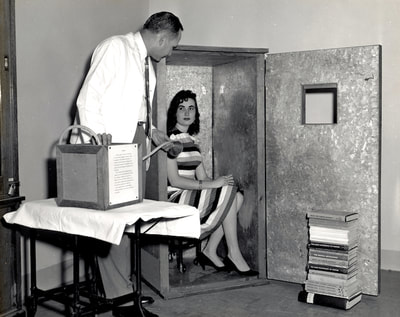 One of the things that makes the history of modern etheric technologies complex is that there isn't a nice straightforward sequence of researchers, each of whom picks up where the previous one left off. More precisely, such a sequence exists -- the development of radionics from Albert Abrams through Ruth Drown to George and Marjorie de la Warr, T. Galen Hieronymus, and David Tansley, among others -- but other researchers such as Leon Eeman and Walter Kilner have stumbled across the same realm of etheric energy and explored it in their own unique ways, coming up with their own terminology and techniques. The subject of this week's post is far and away the most colorful and controversial of these figures: that astonishing force of nature, Wilhelm Reich.
One of the things that makes the history of modern etheric technologies complex is that there isn't a nice straightforward sequence of researchers, each of whom picks up where the previous one left off. More precisely, such a sequence exists -- the development of radionics from Albert Abrams through Ruth Drown to George and Marjorie de la Warr, T. Galen Hieronymus, and David Tansley, among others -- but other researchers such as Leon Eeman and Walter Kilner have stumbled across the same realm of etheric energy and explored it in their own unique ways, coming up with their own terminology and techniques. The subject of this week's post is far and away the most colorful and controversial of these figures: that astonishing force of nature, Wilhelm Reich. The whole sweep of Reich's career requires a book, not a journal post, and Myron Sharaf's biography Fury on Earth is a good option if you're interested. Even his work in the realm of etheric technologies is complex and important enough that it will require two posts, of which this is the first.
To summarize a complex biography very quickly, Reich was one of Sigmund Freud's students in Vienna immediately after the First World War, and unlike most Freudians, came to the conclusion that the best solution to the psychological ills caused by sexual repression was, ahem, less sexual repression. He's the man who invented the phrase "the sexual revolution." He was involved with Marxism in the giddy early days after the Russian Revolution, but ditched it (like many other intellectuals of the time) once Stalin showed conclusively just now nightmarish Marx's theories were when put into practice.
Over time, his research led him deeper and deeper into the complicated territory of sex, where biology meets psychology. He figured out that dysfunctional emotional habits are reflected in specific patterns of body tension, which he called "character armor." He also focused much of his research on the role of orgasm as a release of tension -- a kind of reset button for the body. All this while he was being thrown out of one country after another, because the Communists, the Fascists, the mainstream Freudians, and the churches all found him a convenient punching bag and made as much trouble for him as they could.
He was living in Norway with his second wife when he began to stray across the border into the nonphysical realms. He was researching cancer, which seemed to be associated with certain patterns of character armor and emotional dysfunction, and claimed to find microbes of an unknown type in tissue cultures taken from cancers. Some of these, he noted, appeared through a microscope to be surrounded by little haloes of blue light. Some other people could see those, others couldn't; a close reading of Reichenbach's books could have clued Reich in to what was going on, but I haven't encountered any evidence yet that he read Reichenbach. So he continued his researches, convinced that what he was studying was a physical reality rather than an etheric one.
 In 1939, just before war broke out, he relocated to the United States and continued his researches on the mechanism of the orgasm. His theory while he was in Norway was that the orgasm was an electrochemical release of energy, but around the time he arrived in the United States his experiments convinced him that he had discovered an energy unknown to science, which behaved a little like electricity but was closely linked to biological life. (Sound familiar?) He called this energy "orgone."
In 1939, just before war broke out, he relocated to the United States and continued his researches on the mechanism of the orgasm. His theory while he was in Norway was that the orgasm was an electrochemical release of energy, but around the time he arrived in the United States his experiments convinced him that he had discovered an energy unknown to science, which behaved a little like electricity but was closely linked to biological life. (Sound familiar?) He called this energy "orgone." Experiments with Faraday cages, which are used to shut out electromagnetic radiation, led him to the discovery that certain material structures appear to concentrate orgone. If you make a box of alternating layers of conductive and insulating materials, orgone appears to concentrate within it. Remember Mesmer's baquets, with their layers of conductive metal or water separated by glass and other insulative materials?) That led him to construct boxes large enough to sit in, like the one above, as orgone accumulators. This is where we'll leave him for this week, recruiting volunteers to sit in orgone accumulators and testing the effects on their physical and mental well-being. In next week's installment we'll talk about the strange places Reich's researches led him, and the savage response of the American medical industry to his discoveries.